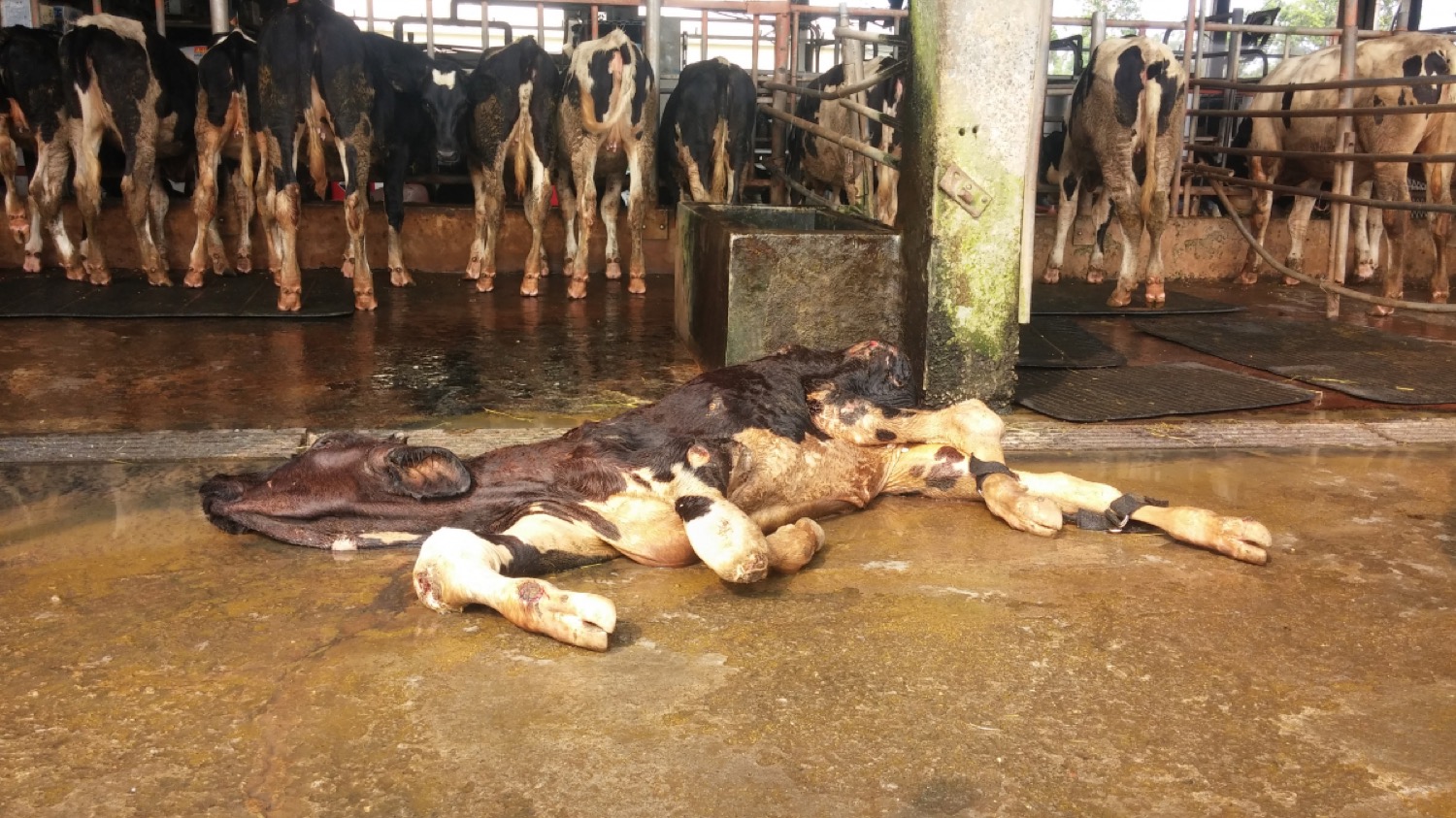Council of Agriculture promises guidelines for sick and injured farmed animals after accusations of inhumane neglect

On October 27, the Environment & Animal Society of Taiwan (EAST) and legislator Chen Ting-Fei (DPP) held a joint press conference to lay bare the plight of sick and injured farmed animals in Taiwan. In the absence of official regulations on humane emergency killing, these animals – estimated to number nearly ten million per year – are often left stranded between life and death.
EAST unveiled images from a series of investigations which showed sick and injured animals in serious states of neglect on Taiwanese farms ‒ ducks with broken legs caught between cage wires, left to be trampled on by their companions; a sick and emaciated pig abandoned without feed; a calf unable to stand abandoned on the edge of a paddock, with keepers admitting she had been left there to die for three days.
According to official statistics, at the end of last year there were as many as 100 million poultry, six million pigs and 160,000 cattle on farms in Taiwan. Despite the huge number of animals, there are less than 500 full-time or contracted veterinarians in direct care of animals on the more than 20,000 farms throughout Taiwan.
Yu-Min Chen, deputy chief executive of EAST, accused the Council of Agriculture (COA) of dereliction of its duty to protect animal welfare, having failed to formulate regulations for the treatment of sick and injured animals in the 20 years since the introduction of the Animal Protection Act. Each year, nearly 10 million sick and injured animals are forced to endure abandonment, neglect or death through inhumane means – such as suffocation – according to conservative estimates.
Taiwan’s Animal Protection Act states that owners shall provide necessary medical care to sick or injured animals. The law also lists relieving animals’ pain from injury or illnesses as a legitimate reason to kill an animal and requires this be done “in a humane way to minimize animals’ pain.”
Taiwan’s humane slaughter regulations were not published until 2008, but to this day, only apply to animals killed in slaughterhouses. This means there are currently no regulations in place for humane emergency killing of sick or injured animals on farms in Taiwan. Last year, EAST demanded the Council of Agriculture devise such regulations and commission scholars to conduct professional training of farm personnel, however the authorities failed to act.
The World Organisation for Animal Health (WOAH), European Union and New Zealand have all promulgated standards for the humane emergency killing of sick and injured animals.
The WOAH code states that it is “unacceptable” to allow a sick or injured animal to linger unnecessarily, and animals with severe health problems should be isolated and treated immediately. Animals which are unable to be treated or are unlikely to recover should be humanely killed via acceptable methods.
European Union regulations define emergency killing as the killing of sick or injured animals where it is the only practical means to alleviate their pain or suffering. The regulations demand animals be spared any avoidable pain, distress or suffering during their killing and related operations.
New Zealand’s codes of animal welfare for dairy cattle, goats, sheep and beef cattle state that animals experiencing severe pain or suffering due to illness, injury or emergency should be killed on-the-spot if transporting them would significantly perpetuate or aggravate their condition. New Zealand’s Animal Welfare Act also makes it an offence to kill an animal in a way that causes unreasonable or unnecessary pain or suffering.
One Taiwanese pig farm has already imported advanced on-farm stunning equipment from overseas, enabling it to relieve pigs suffering from incurable illnesses or injuries in a way which minimizes their suffering. However, this is an industry-wide problem which requires an industry-wide solution.
A number of academics backed the calls for new regulations, stating they would help strengthen understanding of animal welfare among farmers, promote better treatment of animals, and reduce the psychological burden on those who carry out humane emergency killing.
Legislator Chen Ting-Fei expressed “it is incredibly distressing to see sick and injured animals on farms left to fend for themselves or suffer improper treatment.” She called on the authorities to enact humane emergency killing regulations for animals stricken by sickness or injury on farms. She also argued for isolated hospital areas on farms and mandatory training for farm personnel.
At the press conference, the Director of the Department of Animal Industry, COA, Chang Ching-Wei, responded positively to several demands, pledging to formulate guidelines for the humane emergency killing of sick and injured animals within the next three months. He also committed the Department to providing subsidies to help farms acquire the equipment needed for humane emergency killing, establishing relevant training for farm personnel, assessing the feasibility of isolated hospital areas on farms, and incorporating humane emergency killing requirements into Taiwan’s existing species-specific farmed animal welfare guidelines.
Media contact
Ting-Yu Chen, Researcher
Environment & Animal Society of Taiwan (EAST)
Mobile: +886 (9) 6011 1932
Phone: +886 (2) 2236 9735










